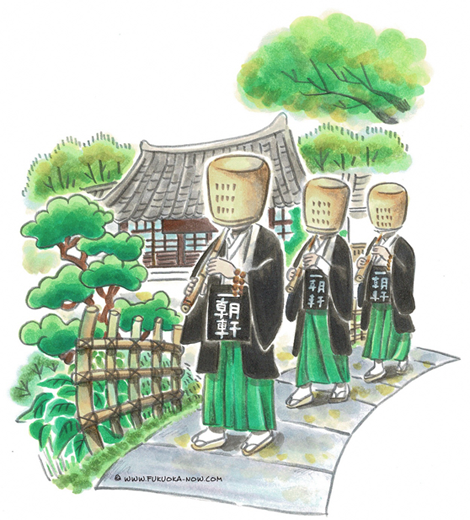Hakata Culture vol.176
The Shakuhachi of the Komuso: A Tradition Alive and Well in Hakata

Komuso were Buddhist priests who wore woven straw baskets called tengai on their heads and travelled around the country playing the shakuhachi flute. These uniquely dressed monks often appear in historical dramas, and many people have surely seen them in these shows and films. Originally, komuso were ascetic monks from a sect of Zen Buddhism called the Fuke sect. This sect aimed to attain enlightenment by playing the shakuhachi. The monks did not shave their heads, but instead wore the basket-like hats and played the shakuhachi while begging for alms.
Although these monks may seem to be a thing of the distant past, there are still temples that carry on the tradition to this day. Icchoken in Hakata Ward is one of the few remaining temples where komuso still practice. During the Kan'ei era (1624-43), some monks from Myoanji Temple in Kyoto came to Hakata to open the first komuso temple in Chikuzen Province. After relocating several times, the komuso found a home within the premises of Saikoji Temple, in what is now Gokushomachi in Hakata Ward.
This became the home of a shakuhachi tradition called "Icchoken Denpochiku." It is also referred to as the Myoan School (or Kyushu Myoan School) because it was handed down from Myoanji Temple in Kyoto. Because the government banned the Fuke sect during the Meiji era (1868-1912), all the komuso temples in the country, including Icchoken, were temporarily abolished, but the shakuhachi tradition was handed down over the generations and was eventually revived. The current chief priest, who is the 22nd generation, is now the steward of this shakuhachi tradition.
In the Fuke sect, the shakuhachi is considered an instrument of meditation, so monks learn to play it in a temple’s dojo. Members of the general public can also learn to play the shakuhachi at the dojo at Icchoken, and players who learn all 60 songs of the tradition are certified as shakuhachi masters. In fact, some of the temple’s shakuhachi pupils are foreigners who are interested in Japanese culture. Although the players typically perform in various places, these performances have been temporarily suspended due to the COVID-19 pandemic. Their training, however, continues.
現代に伝わる虚無僧の尺八
天蓋という深い編笠をかぶり、尺八を吹きながら全国を行脚して回る虚無僧。その独特の姿は時代劇にも度々登場し、目にした人も多いと思います。虚無僧は、もともと普化宗という禅宗の一派の修行僧です。この宗派は尺八を吹くことで悟りを得ることを目指していて、剃髪はせずに深編笠をかぶって尺八を吹いて托鉢していました。
こうした虚無僧は遠い昔の存在のように思われていますが、現代にもその伝統を受け継ぐ寺がまだ存在しています。博多の一朝軒も数少ない虚無僧寺のひとつです。寛永年間(1624~43年)に京都明暗寺の僧が博多に下り、筑前で最初の虚無僧寺を開きました。その後は何度か場所を移し、現在は博多区御供所町の西光寺内に移っています。
そして、ここに伝わるのが「一朝軒伝法竹(でんぽうちく)」という尺八の音曲です。京都明暗寺の流れをくむことから明暗流(または九州明暗流)とも呼ばれています。明治時代に政府が普化宗を禁止したため、一朝軒を含む全国の虚無僧寺は一時廃滅してしまうのですが、尺八奏法はその後も受け継がれて、やがて復興します。今は第22代目の看主が尺八の伝統を守っています。
普化宗では尺八は修行の道具であり、学ぶ場は修行の道場です。一朝軒の道場では一般の人も尺八を学ぶことができ、60曲を超える音曲をすべて覚えると免許皆伝の証しが授けられます。日本文化に興味を持って尺八を学ぶ外国人もいるそうです。さまざまな場所で演奏活動もしてきましたが、新型コロナの影響で一時休止中。それでもこつこつと修行を続けています。

